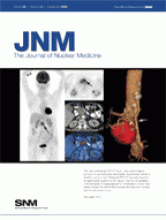REPLY: The clinical case presented by Zöphel and Kotzerke emphasizes the complexity of 18F-FDG myocardial uptake, whose variability remains a controversial issue in the literature. The case is also an added demonstration of the marked, consistent variability in global myocardial 18F-FDG uptake, for which the mutual influence of systemic mediators of cell membrane glucose transporters (GLUTs) can easily be argued as the main reason. During routine 18F-FDG PET examinations of fasting patients, we have also observed an individual variability in global glucose uptake related to the interval after 18F-FDG administration and the delay in the timing of data acquisition. In some patients in whom the myocardium on PET reconstruction was only faintly appreciable at 1 h, myocardial uptake was sharply improved when the PET acquisition was repeated 2 h after tracer injection.
In addition to the influence of biologic mediators on the systemic synchronization of glucose uptake by cells, a regional glucose uptake mechanism may sometime emerge and dominate myocyte glucose internalization independently of insulin, adrenalin, and several other mediators of global myocardial uptake. It is well known that in chronic regional left ventricular dysfunction, this mechanism aims at the survival of myocardium. Hibernation and chronic ischemia are not the only examples of microsystem autoregulation of the regional metabolism of the myocardium; several “nearby normal” physiologic situations probably can induce the same regional phenomenon. When blood flow or substrate supply declines, production of high-energy phosphate becomes oxygen-limited, and glucose can be considered more oxygen-efficient than free fatty acid. Translocation of GLUTs, especially of the relatively insulin-independent GLUT-1, from cytosol to the cell membrane and increased expression of GLUTs are the metabolic pathways used for energy production within this independently operating and functioning microsystem (1–4).
In conclusion, we believe that the major contribution of our observational study was to document changes at the local level and that these changes were independent of the global myocardial integrated system. In fact, an extremely large variability in regional myocardial uptake was demonstrated on repeated whole-body 18F-FDG PET/CT in fasting oncologic patients without heart disease. Thus, an unpredictable opposite change in glucose uptake can be documented over time, comparing the 18F-FDG segmental uptake in 2 contiguous myocardial regions (5).
Therefore, as a cautious guideline, if the clinical question is myocardial viability and the 18F-FDG study is performed under fasting conditions, when regional myocardial glucose uptake is evident and exceeds perfusion tracer uptake, residual myocardial viability can reliably be confirmed. In contrast, if regional 18F-FDG uptake cannot be visually and quantitatively documented, scarred tissue can be suspected but not confirmed.
Footnotes
-
COPYRIGHT © 2008 by the Society of Nuclear Medicine, Inc.







